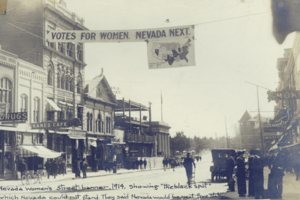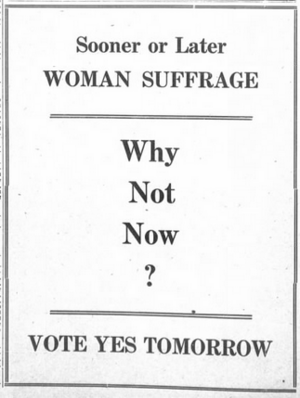Timeline of women's suffrage in Nevada facts for kids
This is a timeline of how women in Nevada gained the right to vote. This right is called women's suffrage. In 1869, a law to let women vote was first suggested in the Nevada Legislature. It passed, but it needed to pass again later.
The first meeting for women's voting rights in Nevada happened in 1870. Over the years, many attempts were made to change the state's rules to allow women to vote. In the 1880s, women won the right to run for school offices. Several women ran and won these jobs.
Work for women's suffrage slowed down around 1899. But in 1911, the Nevada Equal Franchise Society (NEFS) was formed. That same year, a lawyer named Felice Cohn wrote a new bill for women's suffrage, which passed. Anne Henrietta Martin became the leader of NEFS in 1912.
In 1913, Cohn's bill passed a second time. This meant it would go to the voters to decide. On November 3, 1914, Nevada voters approved women's suffrage! Women in Nevada kept working for voting rights across the country. On February 7, 1920, Nevada officially approved the Nineteenth Amendment, which gave women the right to vote everywhere in the United States.
Contents
Early Efforts for Women's Vote
1860s: First Steps
1869
- Curtis J. Hillyer suggests a bill for equal voting rights in the Nevada Legislature. It passes, but it needs a second vote in two years to become part of the state's rules.
1870s: Early Meetings and Setbacks
1870
- July 4: The first meeting about women's voting rights in Nevada takes place in Battle Mountain.
1871
- The voting rights bill from Hillyer does not pass its second required vote.
1873
- Another bill for equal voting rights is suggested but does not pass.
1880s: Winning School Offices
1881
- A group in the Nevada Legislature suggests changing the state rules to allow women to vote, but it doesn't get enough support.
1883
- Hannah K. Clapp helps lead the effort for a women's suffrage bill in the Nevada Senate. It passes there but not in the Assembly.
1885
- A bill for women's voting rights passes in the Nevada Legislature. It needs to be approved again in two years.
1887
- The women's voting rights bill fails to pass a second time.
- However, a bill allowing women to run for school offices passes. It also needs a second vote in two years.
1889
- The school office bill passes! Now, women can run for these positions.
1890s: Women in Office and New Groups
1890
- Several women are elected to school trustee jobs. Two women, Susan Miller and Josephine Taylor, become school superintendents.
1894
- November 30: The Lucy Stone Non-Partisan Equal Suffrage League is formed in Austin, Nevada.
1895
- February: A bill for equal voting rights passes the Nevada Legislature. It needs a second approval in two years.
- May 17: Famous suffrage leaders Susan B. Anthony and Anna Howard Shaw visit Nevada.
- October 29–30: A state meeting for voting rights is held in Reno. The State Equal Suffrage Association is created.
1896
- September 24: A second state meeting for voting rights is held in Reno.
1897
- The equal voting rights bill does not pass a second time.
- October 30: A third state meeting for voting rights is held in Carson City.
1898
- Petitions supporting women's voting rights are sent all over Nevada.
1899
- The fourth state meeting for voting rights is held.
- The State Suffrage Association stops its work.
The 20th Century: The Big Win
1900s: Renewed Efforts
1907
- Women are told they cannot serve as Deputy State Superintendents of Public Instructions.
1909
- The Nevada Legislature approves a bill to allow women to be elected or appointed as school superintendents and notaries public.
1910s: Victory in Nevada
1911
- February 4: The Nevada Equal Franchise Society (NEFS) is started.
- Lawyer Felice Cohn writes a bill for women's suffrage that passes the Nevada Legislature.
- The 1909 bill about women as school superintendents and notaries passes a second time. It will now go to voters to decide.
- Cohn creates the Non-Militant Suffrage Association.
1912
- Anne Henrietta Martin becomes the president of NEFS.
- During the 1912 election, supporters of women's voting rights stand at polling places. They remind voters to choose candidates who support women's suffrage.
- Voters approve the bill allowing women to be school superintendents and notaries.
- NEFS finds out which politicians support women's suffrage and then campaigns for them.
1913
- The 1911 women's suffrage bill written by Cohn passes a second time. It will now go to the voters as a referendum.
- October 30: The Nevada Federation of Women's Clubs (NFWC) officially supports women's suffrage.
1914
- A Nevada Men's League is created to support women's suffrage.
- November: The Nevada Association of Women Opposed to Equal Suffrage (NAWOWS) is formed in Reno.
- November 3: Cohn's suffrage bill wins! Nevada voters approve it with 10,936 votes for and 7,257 against.
- The Washoe County Equal Franchise Society closes and forms the Woman Citizens' Club.
1915
- February: At a state meeting in Reno, NEFS is closed. The Nevada Woman's Civic League is formed.
1916
- April 26: The Suffrage Special train, carrying suffrage leaders, stops in Reno.
- April 27: Delegates from the Suffrage Special meet with Governor Emmet D. Boyle in Carson City. They try to get women interested in a new women's political party.
- Martin travels with the Suffrage Special for part of its journey.
- Nevada women can now vote for the first time in county and state elections.
1918
- August: The Woman Citizens' Club supports Sadie D. Hurst for the Nevada Assembly.
- November: Hurst wins and becomes the first woman to hold office in the Assembly.
1919
- January: Hurst suggests a bill to the United States Congress showing Nevada's support for a national suffrage bill. It passes.
- November: A meeting is held in Reno with Carrie Chapman Catt speaking. The Nevada League of Women Voters is formed.
1920s: National Voting Rights
1920
- February 7: A special meeting of the Nevada Legislature is called to quickly approve the Nineteenth Amendment. Hurst leads the meeting, and the amendment passes.
1924
- The Indian Citizenship Act is passed. This gives Native American women more voting rights.
1930s: Modernizing Voting Rules
1939
- March: A bill suggested by Luella Kirkbride Drumm is approved. This bill removes the rule that married women in Nevada must use "Mrs." when registering to vote under their own first names.





